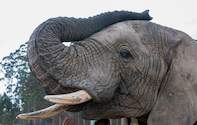
During the 70s, former warden of the Park, dr U de V (Tol) Pienaar had a vision to share the beauty and splendour of Kruger's Big Tuskers with the rest of the world. What began as an attempt to offset the negative publicity that the Park was getting with its culling programme outlived its original purpose as, to this day, people worldwide remember and talk about the "Magnificent Seven."
Though all of the original big tuskers have died, a new generation is walking in their footprints. Dr Ian Whyte, Kruger's well-known elephant researcher and man responsible for the elephant census each year, has teamed up with Kirstie Redman, Interpretive Officer at the elephant museum, to let their legacy live on.
They have gathered vital support from the honorary rangers and have started a project where about ten 'new' big tuskers have been identified of which seven have been named. "Our policy is to name the big tuskers after rangers and field rangers who have given many years' service to the Park," says Ian.
The one exception is Mamerle, a beautiful elephant cow with exceptional tusks and also the mother of three to four year old twins. She is Kruger's biggest female tusker and is named after another matriarch in Kruger.
1. Duke
Duke is currently the largest of the tuskers in KNP, and therefore perhaps the biggest in the world. His home range is in the Lower Sabie/Crocodile Bridge/Tshokwane area. He is named after one of the Park's earliest rangers, Tom Duke, who was based at Lower Sabie between 1903 and 1923. Duke is probably the most photographed of the big tuskers. He is of a very relaxed disposition.
2. Mac
Mac is almost a mythical elephant because he has so seldom been seen. He was photographed once from the helicopter, but has not been seen since. He may therefore have died without his carcass or tusks having been located. He is named after the former Ranger Hector MacDonald who was based at Crocodile Bridge.
3. Masbambela
Masbambela has only recently "discovered" as his home range is to the west of Shingwedzi, generally well away from the main tourist routes. He has been seen at Gumbandevu (Punda Maria) and Red Rocks (Shingwedzi) His tusks are probably only second in size to Duke's. He has been named after Ranger Ben Pretorius who served most of his working life in Kruger. He was known by his Field Rangers as Masbambela which means "one who can "stand his man" in the work place by his physical strength". Ben passed away in September 2002. Not sure of the meaning here "stand by his man" you can leave it as it is but it is a bit unclear.
4. Masunguine
Masunguine is another recently identified tusker who was first photographed from the helicopter in August 2004 in the Mahlati (Shingwedzi) area. He is named after Phineas Massunguine Maluleke who was a Field Ranger in Kruger for many years. More information is needed on his movements and home range. He appears to be still relatively young, and therefore has the potential of becoming one of Kruger's biggest.
5. Muliluane
Muliluane was named after Ranger Harry Kirkman who served in the Kruger between 1933 and 1958. This named seemed appropriate as this elephant moves between Kruger and the Sabie-Sand Private Nature Reserve. Harry Kirkman started his career in the Sabie-Sand, then moving to Kruger as a Ranger and returning to Sabie-Sand as Warden after his retirement from Kruger.
6. Mabarule
Mabarule unfortunately died recently (circa 8th November 2004) apparently of natural causes as his carcass was found with the tusks still in place. He lived in the Mopanie area of Kruger and was given this name by the Field Rangers of the Mooiplaas Section. This is the same name they gave to Ranger Johann Oelofse - the meaning of the name being "Big feet". He was an extremely docile elephant who was often seen and photographed by tourists.
7. Mashagadzi
Mashagadzi was given this name by staff in the Shingwedzi area. This is the name of a windmill just south of Shingwedzi restcamp at which this big tusker is often to be seen. He is also a very docile bull and is often seen and photographed by staff and tourists.
8. Tshilonde
This tusker has not been seen recently and may therefore have died. When last seen he had broken one of his tusks. Like Mashagadzi he lived in the area around Shingwedzi restcamp, and was often seen by tourists.
9. Hlanganini
Hlanganini is a bull who has his home range in the Letaba area. He is also one of the younger bulls with considerable promise for the future. His most recognisable characteristic is that the bottom of his left earlobe is missing - it appears to have been torn off in a straight line parallel to the ground. He gets his name from the Hlanganini River joins the Letaba River at Letaba Restcamp.
10. MaMerle
This beautiful elephant cow is thought to be the biggest female tusker in Kruger. She was first seen and photographed near the Sabie River high-water bridge on 14th August 2004. She was also photographed during the 2004 elephant census from the helicopter. She appears to have twins of about 3-4 years old as they were with her on both occasions. She is named after one of the other matriarchs in Kruger - Merle Whyte who also has an extended family living in Kruger and the associated private nature reserves.
Read more about the Big Tuskers of Kruger

